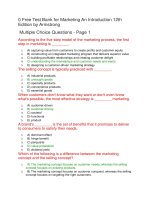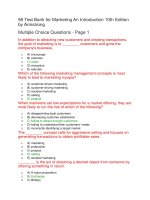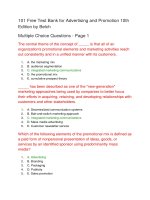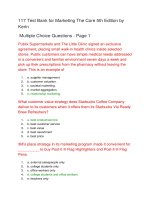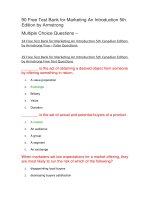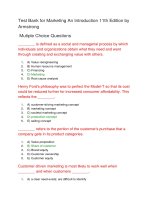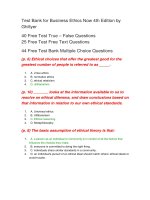Test bank for business essentials 8th canadian edition by ebert
Bạn đang xem bản rút gọn của tài liệu. Xem và tải ngay bản đầy đủ của tài liệu tại đây (173.74 KB, 64 trang )
TEST BANK FOR BUSINESS ESSENTIALS 8TH CANADIAN
EDITION BY EBERT
1) Profit is
A) what remains after business expenses are subtracted from business revenues.
B) what remains after dividends have been paid to stockholders.
C) equal to total revenue minus cash expenses.
D) what remains after income taxes have been paid.
E) double the amount the company pays in.
Answer: A
Diff: 1 Type: MC Page Ref: 5
Skill: Knowledge
Objective: 1.1
2) What are profits?
A) Total money taken in by a corporation
B) Increases in income from year to year
C) Increases in a corporation's stock price
D) Revenue generated by goods and services
E) Difference between revenues and expenses
Answer: E
Diff: 1 Type: MC Page Ref: 5
Skill: Knowledge
Objective: 1.1
3) Profit is
A) the market value of shares of stock in a company.
B) the level of expenses divided by the firm's assets.
C) what remains after business expenses are subtracted from business revenues.
D) gross revenue minus taxes a company pays.
E) gross sales minus taxes a company pays.
Answer: C
Diff: 1 Type: MC Page Ref: 5
Skill: Knowledge
Objective: 1.1
Copyright © 2017 Pearson Canada Inc.
1-1
4) This week, Abe's Muffler Shop had sales of $4000, employees were paid $1000, the cost of
goods was $1500, and rent was $500. Profit for the week was
A) $3000.
B) $1000.
C) $4000.
D) $2500.
E) $500.
Answer: B
Diff: 2 Type: MC Page Ref: 5
Skill: Application
Objective: 1.1
5) How are provincial universities in Canada different from business firms?
A) They do not seek to make a profit.
B) They deal with people, not things.
C) Their organizational boundaries exclude business firms.
D) They do not produce goods or services.
E) They are more important to society than business firms.
Answer: A
Diff: 2 Type: MC Page Ref: 5
Skill: Comprehension
Objective: 1.1
6) Forbes magazine ranked 134 countries in terms of how attractive they were to do business in.
Where did Canada rank?
A) First
B) Second
C) Fifth
D) Twenty-fifth
E) Eighty-seventh
Answer: A
Diff: 2 Type: MC Page Ref: 5
Skill: Knowledge
Objective: 1.1
7) Examples of businesses include all of the following except
A) local supermarkets.
B) one-person businesses, like barbershops.
C) non-profit organizations.
D) large corporations like Canadian Pacific or Alcan Aluminum.
E) farms.
Answer: C
Diff: 2 Type: MC Page Ref: 5
Skill: Comprehension
Objective: 1.1
Copyright © 2017 Pearson Canada Inc.
1-2
8) ________ produce most of the goods and services consumed in Canada.
A) Businesses
B) Labour unions
C) Non-profit organizations
D) Canadian provincial governments
E) Charities
Answer: A
Diff: 1 Type: MC Page Ref: 5
Skill: Comprehension
Objective: 1.1
9) Not-for-profit organizations
A) are content with small profits, whereas business firms want large profits.
B) are more important than business firms in the Canadian economy.
C) use the funds from government grants or from the sale of goods or services to provide service
to the public.
D) sell only services, not goods.
E) are not allowed to operate in the manufacturing sector.
Answer: C
Diff: 2 Type: MC Page Ref: 5
Skill: Comprehension
Objective: 1.1
10) If two people exchange an apple, they each still have just one apple, but if they exchange
ideas, they now each have two ideas. This is an illustration of
A) the importance of natural resources.
B) the principle of specialization of labour.
C) the difference between information and all the other factors of production.
D) the importance of profit in market economies.
E) the importance of government regulation.
Answer: C
Diff: 2 Type: MC Page Ref: 5
Skill: Comprehension
Objective: 1.2
11) The key difference between economic systems is the different ways in which they manage
A) the factors of production.
B) the transportation of goods within their borders.
C) government rules and regulations.
D) the payment of workers.
E) the degree of competition that is allowed in various domestic industries.
Answer: A
Diff: 2 Type: MC Page Ref: 5
Skill: Knowledge
Objective: 1.2
Copyright © 2017 Pearson Canada Inc.
1-3
12) An economic system is
A) an agreement between countries that deals with free trade.
B) the way in which a nation allocates its resources among its citizens.
C) a government decree that requires certain goods and services to be provided.
D) a long standing agreement between citizens and governments on how an economy is run.
E) a large government department that oversees how the economy is running.
Answer: B
Diff: 2 Type: MC Page Ref: 5
Skill: Knowledge
Objective: 1.2
13) What does a planned economy rely on a centralized government to do?
A) Support free enterprise in every way possible
B) Allocate all or most factors of production
C) Encourage citizens to buy shares of stock in small companies
D) Keep its control activities to a minimum
E) Direct workers to start their own small businesses
Answer: B
Diff: 2 Type: MC Page Ref: 5
Skill: Knowledge
Objective: 1.2
14) In a command economy, the central government
A) supports free enterprise in every way possible.
B) decides on the allocation of all or most factors of production.
C) encourages citizens to buy shares of stock in small companies rather than large ones.
D) keeps its control activities to a minimum so it doesn't interfere with business efficiency.
E) creates shortages on purpose in order to motivate businesses to be more efficient.
Answer: B
Diff: 2 Type: MC Page Ref: 5
Skill: Knowledge
Objective: 1.2
15) In terms of factors of production, Imperial Oil's crude oil reserves are an example of
________, while market forecasts are an example of ________.
A) labour; entrepreneurs
B) information; labour
C) capital; information
D) natural resources; information
E) information; natural resources
Answer: D
Diff: 2 Type: MC Page Ref: 5
Skill: Comprehension
Objective: 1.2
Copyright © 2017 Pearson Canada Inc.
1-4
16) With regard to factors of production, it is correct to say that
A) natural resources are pretty evenly distributed across different countries.
B) the factors of production are managed differently in different countries.
C) capital is the most "unfair" factor of production.
D) entrepreneurs are a factor of production only in certain countries (e.g., China).
E) technology is the most important factor of production.
Answer: B
Diff: 3 Type: MC Page Ref: 5
Skill: Knowledge
Objective: 1.2
17) Entrepreneurs are important because they
A) make and spend lots of money.
B) are good at making decisions.
C) take risks to start new businesses.
D) are usually better managers than non-entrepreneurs.
E) sell shares of stock to investors.
Answer: C
Diff: 2 Type: MC Page Ref: 5
Skill: Comprehension
Objective: 1.2
18) Elizabeth wants to set up a consulting business that specializes in mathematical problem
solving. Which of the following factors of production would she require?
A) Capital
B) Labour
C) Information resources
D) Natural resources
E) All of these
Answer: E
Diff: 2 Type: MC Page Ref: 5
Skill: Comprehension
Objective: 1.2
19) "Embrace the opportunities and accept the risks" is a phrase that best characterizes the
________ attitude.
A) entrepreneurial
B) capitalist
C) communist
D) socialist
E) managerial
Answer: A
Diff: 2 Type: MC Page Ref: 5
Skill: Comprehension
Objective: 1.2
Copyright © 2017 Pearson Canada Inc.
1-5
20) Something that would contribute directly to improving labour as a factor of production
would be
A) finding new oil reserves.
B) better education for more of the population.
C) increasing the purchasing power of employees.
D) programs designed to decrease unemployment.
E) finding more efficient ways to produce products.
Answer: B
Diff: 3 Type: MC Page Ref: 5
Skill: Comprehension
Objective: 1.2
21) As a factor of production, labour includes
A) everyone in a business.
B) only non-unionized employees.
C) only unionized employees.
D) only lower-level managers, not upper-level managers.
E) only workers who do production work.
Answer: A
Diff: 2 Type: MC Page Ref: 5
Skill: Knowledge
Objective: 1.2
22) Which of the following is correct with respect to the factors of production?
A) The "labour" factor recognizes that it is importance to have labour unions to offset the power
of management.
B) "Capital" is a more important factor than "labour."
C) As the Canadian economy has become larger and more complex, the importance of
entrepreneurs has declined.
D) Unlike land, labour, and capital, information can be shared without being diminished.
E) Human resources is an example of the "natural resources" factor.
Answer: D
Diff: 2 Type: MC Page Ref: 5
Skill: Comprehension
Objective: 1.2
23) Natural resources as a factor of production for mining are a practical consideration when a
mining company considers
A) the ease with which ore could be mined.
B) the number of miners available to mine the ore.
C) the amount of capital required to build the mine.
D) the profit that can be made from mining the ore.
E) the number of customers who want to buy ore.
Answer: A
Diff: 3 Type: MC Page Ref: 5
Skill: Comprehension
Objective: 1.2
Copyright © 2017 Pearson Canada Inc.
1-6
24) What is the difference between a command economy and a market economy?
A) A command economy is found only in communist countries, while a market economy is
found only in capitalist countries.
B) A command economy is more efficient than a market economy.
C) A market economy gives greater "life satisfaction" to people.
D) A command economy relies on centralized government control of the factors of production,
while in a market economy supply and demand determine production and allocation decisions.
E) There really are no significant differences between a command economy and a market
economy.
Answer: D
Diff: 3 Type: MC Page Ref: 5
Skill: Comprehension
Objective: 1.2
25) What can we say about the dollar value of business-to-business (B2B) transactions compared
to the dollar value of business-to-consumer (B2C) transactions?
A) B2B transactions have a lower dollar value because there are fewer businesses than there are
consumers.
B) The dollar value of B2B transactions exceeds that of B2C transactions.
C) The dollar value of B2B transactions must equal the dollar value of B2C transactions.
D) It is not possible to determine whether the dollar value of B2B transactions is less than or
more than the dollar value of B2C transactions because of industrial secrecy.
E) It is not possible to determine whether the dollar value of B2B transactions is less than or
more than the dollar value of B2C transactions because of data limitations.
Answer: B
Diff: 2 Type: MC Page Ref: 7
Skill: Comprehension
Objective: 1.2
26) The economic system in which producers and consumers control production and allocation
decisions through supply and demand is called
A) a centrally planned economy.
B) privatization.
C) a market economy.
D) communism.
E) socialism.
Answer: C
Diff: 2 Type: MC Page Ref: 7
Skill: Knowledge
Objective: 1.2
Copyright © 2017 Pearson Canada Inc.
1-7
27) Which country has a command economy?
A) Australia
B) Japan
C) Canada
D) Germany
E) North Korea
Answer: E
Diff: 1 Type: MC Page Ref: 7
Skill: Comprehension
Objective: 1.2
28) Which of the following is correct with regard to the communist economic system?
A) The centralized planning emphasis on capital equipment and military hardware has caused
declines in the prices of consumer goods.
B) Government ownership of the means of production is only temporary.
C) Most government-operated enterprises are very efficient because of central planning.
D) Overall production expands rapidly because of central planning.
E) The government owns and operates all sources of production.
Answer: E
Diff: 2 Type: MC Page Ref: 7
Skill: Comprehension
Objective: 1.2
29) Stanislav lives in a country where all the factors of production are owned by the government.
The economic system in his country is most likely
A) communism.
B) capitalism.
C) mixed market.
D) socialism.
E) it is not possible to tell with the information provided.
Answer: A
Diff: 2 Type: MC Page Ref: 7
Skill: Comprehension
Objective: 1.2
30) John lives in a country where producers and consumers control production, and where
allocation decisions are made through the mechanism of supply and demand. John lives in a
country with a ________ economy.
A) privatized
B) socialist
C) communist
D) market
E) nationalized
Answer: D
Diff: 2 Type: MC Page Ref: 7
Skill: Comprehension
Objective: 1.2
Copyright © 2017 Pearson Canada Inc.
1-8
31) A GlobeScan poll showed that the highest support for the free market economy was found in
A) Japan.
B) China.
C) the United States.
D) Canada.
E) Brazil.
Answer: B
Diff: 2 Type: MC Page Ref: 7
Skill: Knowledge
Objective: 1.2
32) A major drawback to communism as an economic system is that
A) government control of the factors of production is only temporary.
B) people don't like communism.
C) individuals contribute according to their ability.
D) individuals receive economic benefits according to their needs.
E) production of goods and services is inefficient because of the lack of a profit incentive.
Answer: E
Diff: 3 Type: MC Page Ref: 7
Skill: Comprehension
Objective: 1.2
33) Command economies are most likely to be found in
A) the newly emerging economies of southeast Asia.
B) communist and socialist nations.
C) western European countries.
D) Japan.
E) Canada and the United States.
Answer: B
Diff: 2 Type: MC Page Ref: 7
Skill: Comprehension
Objective: 1.2
34) An economy that has a strong central government that controls labour, capital, and natural
resources and has few entrepreneurs is a
A) market economy.
B) command economy.
C) free-enterprise economy.
D) capitalist economy.
E) oligopolistic economy.
Answer: B
Diff: 1 Type: MC Page Ref: 7
Skill: Knowledge
Objective: 1.2
Copyright © 2017 Pearson Canada Inc.
1-9
35) Communism and socialism are
A) basic forms of market economies.
B) becoming more popular.
C) extreme opposites.
D) basic forms of command economies.
E) identical forms.
Answer: D
Diff: 2 Type: MC Page Ref: 7
Skill: Knowledge
Objective: 1.2
36) Mexico allows producers and consumers to make production and allocation decisions
through the mechanism of supply and demand. Such a system is called
A) socialism.
B) communism.
C) privatization.
D) nationalization.
E) a market economy.
Answer: E
Diff: 1 Type: MC Page Ref: 7
Skill: Comprehension
Objective: 1.2
37) Socialist economies may stifle economic growth because
A) management positions in state-controlled industries are often filled on the basis of political
considerations.
B) they have too few regulations concerning product safety.
C) they are found in countries where people don't have many skills.
D) they are usually found in countries with cold climates.
E) they encourage excessive unionization of employees.
Answer: A
Diff: 3 Type: MC Page Ref: 7
Skill: Comprehension
Objective: 1.2
38) An economic system that permits private ownership and control of small businesses but
where the government controls large critical industries is known as
A) a mixed economy.
B) socialism.
C) communism.
D) capitalism.
E) mercantilism.
Answer: B
Diff: 1 Type: MC Page Ref: 7
Skill: Knowledge
Objective: 1.2
Copyright © 2017 Pearson Canada Inc.
1-10
39) Which of the following statements is correct?
A) Sweden is the best example of a country with a pure socialist economy.
B) A GlobeScan poll found that the greatest support for the free market economy was found
among the citizens of India.
C) The United States is a pure capitalist economy.
D) Many countries in the world have a purely communist economy.
E) Under socialism, smaller businesses are often privately owned.
Answer: E
Diff: 3 Type: MC Page Ref: 7
Skill: Comprehension
Objective: 1.2
40) Which of the following is correct with regard to the issue of different economic systems?
A) There is a general consensus that command economies are more efficient than market
economies because a centralized government can consider a wider range of economic factors
when decisions are made.
B) In recent years, more and more countries have rejected communism and embraced more
market-based economies.
C) Socialism is the most extensive command economic system because government owns all the
major industries.
D) A GlobeScan poll of 20 000 people in 20 different countries showed that support for a free
market economy was most pronounced in Singapore.
E) All of these are correct.
Answer: B
Diff: 2 Type: MC Page Ref: 7
Skill: Comprehension
Objective: 1.2
41) Socialism is best described as
A) a kind of command economy in which the government owns and operates all industries.
B) a kind of command economy in which the government owns and operates large critical
industries.
C) an economy that is free from any regulation or planning.
D) a market economy in which markets decide what, when, and how much to produce.
E) an economic system with elements of a market economy, but not a planned economy.
Answer: B
Diff: 2 Type: MC Page Ref: 7
Skill: Comprehension
Objective: 1.2
Copyright © 2017 Pearson Canada Inc.
1-11
42) Market economies have all of the following characteristics, except that they
A) allow businesses to charge whatever they want for their products and services.
B) encourage entrepreneurship by offering profits as an incentive.
C) require government intervention in order to prosper.
D) rely on markets, not governments, to decide what, when, and for whom to produce.
E) allow customers free choice.
Answer: C
Diff: 2 Type: MC Page Ref: 7
Skill: Comprehension
Objective: 1.2
43) Which of the following is correct with respect to privatization and deregulation?
A) Deregulation yields higher economic performance than privatization.
B) Privatization only works in socialist countries.
C) Privatization means converting companies that are in financial trouble into governmentcontrolled organizations.
D) The trend toward both privatization and deregulation slowed somewhat after the financial
crisis of 2008.
E) They mean essentially the same thing.
Answer: D
Diff: 3 Type: MC Page Ref: 8
Skill: Comprehension
Objective: 1.2
44) Canada is home to a(n) ________ economy.
A) mixed market
B) oligopolistic
C) socialist
D) market
E) command
Answer: A
Diff: 2 Type: MC Page Ref: 8
Skill: Knowledge
Objective: 1.2
45) Market economies are considered beneficial for small businesses because they
A) provide small businesses with lots of government assistance and protection.
B) provide a central economic plan within which small businesses can easily prosper.
C) protect small businesses from the power of large corporations.
D) allow small businesses to fail.
E) allow the business to do whatever it wants as long as it doesn't break the law.
Answer: E
Diff: 2 Type: MC Page Ref: 7
Skill: Comprehension
Objective: 1.2
Copyright © 2017 Pearson Canada Inc.
1-12
46) In which economic system will profit motivate entrepreneurs to use resources efficiently and
to produce goods that consumers want?
A) A centrally planned economy
B) Communism
C) A market economy
D) Socialism
E) A barter economy
Answer: C
Diff: 1 Type: MC Page Ref: 7
Skill: Knowledge
Objective: 1.2
47) Jose is from Guatemala. He is unsure about the nature of business in Canada. You point out
that a typical business in Canada operates in fundamentally the same way as a business in
A) the People's Republic of China.
B) Poland.
C) Peru.
D) England.
E) Japan.
Answer: D
Diff: 3 Type: MC Page Ref: 5
Skill: Comprehension
Objective: 1.2
48) Which of the following is correct with respect to input and output markets?
A) In the input market, firms supply goods and services in response to demand on the part of
households.
B) In the output market, firms buy resources from households, which then supply those
resources.
C) Consumer buying patterns provide information that helps companies decide which products to
produce.
D) Consumers are restricted in the companies they can work for.
E) Input and output markets exist only in communist countries.
Answer: C
Diff: 3 Type: MC Page Ref: 7-8
Skill: Comprehension
Objective: 1.2
Copyright © 2017 Pearson Canada Inc.
1-13
49) Which of the following is correct with respect to mixed market economies?
A) They have features that are not found in either command or market economies.
B) As a result of the financial crisis of 2008, there is a trend toward increased government
regulation of business in mixed market economies.
C) Very few countries have this type of system.
D) There is a trend toward increased government ownership of business in mixed market
economies.
E) The mixed market economy is the best type of economic system.
Answer: B
Diff: 2 Type: MC Page Ref: 8
Skill: Comprehension
Objective: 1.2
50) The federal government sold the Lester B. Pearson International Airport in Toronto to a
group of entrepreneurs, which then set up the Greater Toronto Airports Authority. This sale is an
example of
A) socialism.
B) freedom of choice.
C) entrepreneurship.
D) deregulation.
E) privatization.
Answer: E
Diff: 2 Type: MC Page Ref: 8
Skill: Comprehension
Objective: 1.2
51) Which of the following is correct with respect to privatization?
A) The TNT Post Group in the Netherlands has been converted from private to government
ownership.
B) Privatization is most likely to occur in communist countries.
C) Privatization has been a general trend during the last decade, but some countries are going in
the opposite direction and pursuing nationalization instead.
D) Several companies have been nationalized in Canada in recent years.
E) The recession of 2008 accelerated the trend toward privatization.
Answer: C
Diff: 3 Type: MC Page Ref: 8
Skill: Comprehension
Objective: 1.2
Copyright © 2017 Pearson Canada Inc.
1-14
52) The role of government in our economic system includes all of the following except
A) customers.
B) innovators.
C) competitors.
D) regulators.
E) taxation agents.
Answer: B
Diff: 2 Type: MC Page Ref: 9-11
Skill: Knowledge
Objective: 1.3
53) Sandy is responsible for monitoring compliance with regulations in her company. She needs
to know that the important areas of government regulation are
A) protecting competition and upholding environmental regulations.
B) protecting social goals, upholding environmental regulations, and protecting shareholder
rights.
C) protecting competition, protecting consumers, and upholding environmental regulations.
D) protecting competition, protecting consumers, protecting social goals, and protecting the
environment.
E) protecting shareholder rights, and following business law.
Answer: D
Diff: 2 Type: MC Page Ref: 9-10
Skill: Comprehension
Objective: 1.3
54) The Canada Consumer Product Safety Act replaces the
A) Hazardous Products Act.
B) Food and Drug Act.
C) Weights and Measures Act.
D) Advertising and Packaging Act.
E) Textile Labelling Act.
Answer: A
Diff: 2 Type: MC Page Ref: 10
Skill: Knowledge
Objective: 1.3
Copyright © 2017 Pearson Canada Inc.
1-15
55) Which of the following is correct with regard to the Competition Act?
A) A company can cut prices in one region of Canada while selling at a higher price everywhere
else even if this substantially lessens competition.
B) Businesses are generally satisfied that the Competition Bureau moves fairly quickly in
approving or denying merger plans.
C) Pyramid selling is permitted as long as participant know they are involved in a pyramid
selling scheme and they know they are not allowed to make windfall profits from the scheme.
D) The mere existence of a conspiracy is assumed to be proof that competition has been reduced.
E) All of these are correct.
Answer: D
Diff: 3 Type: MC Page Ref: 9
Skill: Comprehension
Objective: 1.3
56) Madeline is responsible for answering questions about what her company can do under the
Competition Act. Which one of the following is allowed under the Act?
A) The return of surpluses by credit unions to their members
B) Pricing products unreasonably low to eliminate competition
C) Forming a merger or a monopoly that lessens competition
D) Refusing to sell to a retailer who will, in turn, sell the product significantly below the
suggested retail price
E) Giving selective allowances and rebates to cover advertising expenses to specific retailers
Answer: A
Diff: 2 Type: MC Page Ref: 9
Skill: Comprehension
Objective: 1.3
57) Which of the following is correct regarding the Competition Act?
A) The Act prohibits agreements between companies that reduce competition.
B) The government has to prove that agreements between companies actually reduce
competition.
C) Recent changes to the Act have reduced fines for misleading marketing practices because it
has been shown that these fines don't have any effect.
D) Surveys of business executives show that they think the Competition Bureau is actually quite
quick in approving or denying merger requests.
E) All of the above.
Answer: A
Diff: 1 Type: MC Page Ref: 9
Skill: Comprehension
Objective: 1.3
Copyright © 2017 Pearson Canada Inc.
1-16
58) In 2014, Netflix was told to submit information about its Canadian subscribers to the CRTC,
but it refused to do so, arguing that the CRTC didn't have any jurisdiction over online media.
When the CRTC simply dropped the issue, this showed that
A) the CRTC does not have any power over companies that provide cable or television
entertainment.
B) the top management of CRTC is incompetent.
C) the top management of the CRTC is not knowledgeable about companies that provide
entertainment.
D) the CRTC does not have right to control broadcast content that is provided over the Internet.
E) it is unclear what jurisdiction the CRTC has in enforcing Canadian content rules.
Answer: E
Diff: 3 Type: MC Page Ref: 9
Skill: Comprehension
Objective: 1.3
59) Why are sales taxes called regressive taxes?
A) Because food and drugs are often exempt
B) Because the more one makes, the lower the rate of sales tax that is applied to one's purchases
C) Because poorer people pay a higher percentage of their income than richer people
D) Because it applies to sales taxes
E) Because they discourage the purchase of some products
Answer: C
Diff: 3 Type: MC Page Ref: 11
Skill: Comprehension
Objective: 1.3
60) John has just received a rather large increase in salary, but he is upset because he feels that he
should not be charged a higher rate of tax on this extra money. John is being taxed by a
________ tax system.
A) provincial
B) federal
C) progressive
D) restrictive
E) regressive
Answer: C
Diff: 2 Type: MC Page Ref: 11
Skill: Knowledge
Objective: 1.3
Copyright © 2017 Pearson Canada Inc.
1-17
61) Which of the following is correct with respect to the issue of government taxation?
A) Progressive revenue taxes are harder on low-income people than on high-income people.
B) Revenue taxes are designed primarily to encourage people to buy certain kinds of goods and
avoid buying other kinds.
C) Restrictive taxes prevent businesses from expanding.
D) Regressive revenue taxes are levied at the same rate regardless of a person's income.
E) All of the statements are correct.
Answer: D
Diff: 2 Type: MC Page Ref: 11
Skill: Comprehension
Objective: 1.3
62) The GST is considered a regressive tax because
A) food and drugs are often exempt.
B) the more a person makes, the lower the rate of sales tax applied to that person's purchase.
C) it is unfair.
D) poorer people pay a higher percentage of their income than richer people.
E) it is designed to discourage the purchase of certain products.
Answer: D
Diff: 2 Type: MC Page Ref: 11
Skill: Comprehension
Objective: 1.3
63) Incentive programs are designed to
A) encourage families to have more babies.
B) encourage businesses to locate in economically depressed parts of the country.
C) create "corporate welfare bums."
D) encourage families to move to depressed parts of the country.
E) reimburse businesses for making unprofitable but necessary products.
Answer: B
Diff: 2 Type: MC Page Ref: 11
Skill: Comprehension
Objective: 1.3
64) Which law forbids most monopolies in Canada?
A) Consumer Protection Act
B) Lobbying Act
C) Fair Trade Act
D) Competition Act
E) Environmental Contaminants Act
Answer: D
Diff: 1 Type: MC Page Ref: 9
Skill: Knowledge
Objective: 1.3
Copyright © 2017 Pearson Canada Inc.
1-18
65) Nutrition labelling and claims are intended to provide consumers with information to aid
them in the selection of a healthy diet aimed at reducing risk of premature illness and death due
to diet-related chronic diseases. Insufficient labelling is a violation of which act?
A) Food and Drug Act
B) Weights and Measures Act
C) Advertising and Packaging Act
D) Textile Labelling Act
E) Consumer Protection Act
Answer: A
Diff: 2 Type: MC Page Ref: 10
Skill: Knowledge
Objective: 1.3
66) Which of the following statements is most correct with respect to government in its role as
regulator?
A) Business complains that the Competition Bureau is too slow in approving or denying merger
plans.
B) The government really has very little power in its role as regulator.
C) Because of the move toward deregulation, federal and provincial governments have become
less and less involved in regulating business activity.
D) The main areas of government regulation of business are achieving social goals, protecting
consumers, and providing assistance to small business firms.
E) Studies have shown that government regulation reduces the effectiveness of business firms.
Answer: A
Diff: 2 Type: MC Page Ref: 9
Skill: Comprehension
Objective: 1.3
67) Which of the following is correct with regard to public-private partnerships?
A) These partnerships have resulted in windfall profits for the businesses that have gotten
involved in them.
B) These partnerships have resulted in bad public relations for the businesses that have gotten
involved in them.
C) These partnerships have created a monopoly situation for the businesses that have gotten
involved in them.
D) These partnerships cost more money than the traditional approach (where the government
puts up the money and then hires contractors to do the necessary work).
E) These partnerships have generally been failures in terms of the quality of service provided.
Answer: D
Diff: 3 Type: MC Page Ref: 11
Skill: Comprehension
Objective: 1.3
Copyright © 2017 Pearson Canada Inc.
1-19
68) When Labatt Brewing sales representatives gave money to store operators who agreed to not
lower prices on some brands of beer, the company was prosecuted for engaging in
A) bait-and-switch advertising.
B) resale price maintenance.
C) a pyramid scheme.
D) selling mislabeled products.
E) a violation of the Beer Act.
Answer: B
Diff: 2 Type: MC Page Ref: 10
Skill: Comprehension
Objective: 1.3
69) The three main ways in which business can influence government policy are
A) advertising, lobbyists, and trade associations.
B) political contributions, letters to the editors of newspapers, and advertising.
C) advertising, trade associations, and political contributions.
D) trade associations, lobbyists, and letters to the editors of newspapers.
E) lobbyists, political contributions, and advertising.
Answer: A
Diff: 2 Type: MC Page Ref: 11
Skill: Comprehension
Objective: 1.3
70) The federal Lobbying Act requires lobbyists to
A) register with the Department of Consumer and Commercial Relations.
B) contribute a minimum of $10 000 to political campaigns.
C) attend at least two sessions in the House of Commons each year.
D) report on their communications with designated public office holders.
E) meet with members of Parliament on a regular basis.
Answer: D
Diff: 2 Type: MC Page Ref: 12
Skill: Knowledge
Objective: 1.3
71) Suppose that several microelectronics manufacturers want to set up a trade association. They
need to know that trade associations are allowed to do all of the following except
A) allocate markets for their members.
B) influence the kind of legislation that is passed.
C) conduct training programs relevant to the industry.
D) arrange trade shows.
E) publish newsletters featuring articles on new products.
Answer: A
Diff: 2 Type: MC Page Ref: 12
Skill: Comprehension
Objective: 1.3
Copyright © 2017 Pearson Canada Inc.
1-20
72) The price at which the quantity of goods demanded and the quantity of goods supplied are
equal is referred to as
A) the going rate.
B) the point-of-no-return price.
C) the market price.
D) the highest price.
E) the lowest price.
Answer: C
Diff: 2 Type: MC Page Ref: 13
Skill: Knowledge
Objective: 1.4
73) In a small town of 3,000 people, the number of car washes has grown from two to five in the
last two months. Which result will likely occur?
A) The increase in supply will have no effect on the equilibrium price.
B) The increase in supply will lead to a decrease in demand.
C) The increase in supply will lead to a decrease in the equilibrium price.
D) The increase in supply will lead to an increase in demand.
E) The increase in supply will lead to an increase in equilibrium price.
Answer: C
Diff: 2 Type: MC Page Ref: 13
Skill: Knowledge
Objective: 1.4
74) The term "demand" refers to
A) the stock exchange.
B) the willingness and ability of buyers to purchase a product or service.
C) the willingness and ability of businesses to sell a product or service.
D) the willingness of buyers to accept high prices for high quality goods.
E) the willingness of government to sell goods and services.
Answer: B
Diff: 2 Type: MC Page Ref: 12
Skill: Knowledge
Objective: 1.4
75) What is "demand"?
A) The idea that buyers will purchase more of a product as the price drops
B) The price and quantity of a product at which the quantity demanded is equal to the quantity
supplied
C) The idea that producers will offer more of a product as the price rises
D) The willingness and ability of buyers to purchase a product
E) None of these
Answer: D
Diff: 2 Type: MC Page Ref: 12
Skill: Knowledge
Objective: 1.4
Copyright © 2017 Pearson Canada Inc.
1-21
76) With regard to demand and supply in a market economy, it is correct to say that
A) demand refers to the price that consumers are willing to pay for a product.
B) the demand and supply schedule indicates how many units of a given product will be sold at
different prices.
C) demand and supply curves are used to determine the demand and supply schedule.
D) equilibrium prices are only rarely achieved.
E) if a seller tried to increase profits by making more products to sell, the result would be a more
efficient use of resources because economies of scale would be achieved.
Answer: B
Diff: 2 Type: MC Page Ref: 12
Skill: Comprehension
Objective: 1.4
77) The law of demand states that
A) producers will offer more of a product as the price falls.
B) demand and supply meet at an equilibrium point.
C) buyers will purchase more of a product as the price falls.
D) producers will offer more of a product as the price rises.
E) buyers will purchase more of a product as the price rises.
Answer: C
Diff: 1 Type: MC Page Ref: 12
Skill: Knowledge
Objective: 1.4
78) The law of supply states that
A) buyers will purchase more of a product as the price falls.
B) demand and supply meet at an equilibrium point.
C) producers will offer more of a product as the price rises.
D) producers will offer more of a product as the price falls.
E) buyers will purchase more of a product as the price rises.
Answer: C
Diff: 1 Type: MC Page Ref: 12
Skill: Knowledge
Objective: 1.4
79) What is "supply"?
A) The idea that sellers will sell more of a product as the price increases
B) The price and quantity of a product at which the quantity demanded is equal to the quantity
supplied
C) The idea that buyers will want less of a product as the price increases
D) The willingness and ability of producers to offer a good or service for sale
E) None of these
Answer: D
Diff: 2 Type: MC Page Ref: 12
Skill: Knowledge
Objective: 1.4
Copyright © 2017 Pearson Canada Inc.
1-22
80) Ian, the owner of 5-for-1 Pizza, has noticed that when he increases the price of his pizzas by
$2.00, the number of pizzas that he sells drops by 30 percent. Ian has discovered
A) the law of supply and demand.
B) the supply curve.
C) the demand curve.
D) the law of supply.
E) the law of demand.
Answer: E
Diff: 1 Type: MC Page Ref: 12
Skill: Comprehension
Objective: 1.4
81) Kristine discovered that when she dropped the price of her paintings, more people were
asking her to create paintings for them. Kristine is experiencing
A) the law of supply and demand.
B) market price variations.
C) the law of supply.
D) economic justice.
E) the law of demand.
Answer: E
Diff: 2 Type: MC Page Ref: 12
Skill: Comprehension
Objective: 1.4
82) A demand and supply schedule
A) allows assessment of the relationship between different levels of demand and supply at
different prices.
B) describes the supply for a product.
C) describes the demand for a product.
D) is a formula by which one determines market equilibrium.
E) is the contractual agreement made between the buyer and seller.
Answer: A
Diff: 2 Type: MC Page Ref: 12
Skill: Comprehension
Objective: 1.4
83) Which term is used to identify the willingness and ability of buyers to purchase a product?
A) Obligation
B) Demand
C) Wealth
D) Profits
E) Prosperity
Answer: B
Diff: 1 Type: MC Page Ref: 12
Skill: Knowledge
Objective: 1.4
Copyright © 2017 Pearson Canada Inc.
1-23
84) A producer of automobile batteries notes that the price of batteries has risen over each of the
past three years. The firm decides to expand its battery production. This illustrates
A) the law of supply.
B) the law of market price.
C) the law of equilibrium.
D) the law of demand.
E) the law of supply and demand.
Answer: A
Diff: 2 Type: MC Page Ref: 12
Skill: Comprehension
Objective: 1.4
85) The point at which the quantity of a product or service demanded is the same as the quantity
supplied is called
A) the surplus point.
B) the equilibrium point.
C) the supply point.
D) the profit point.
E) the demand point.
Answer: B
Diff: 1 Type: MC Page Ref: 12
Skill: Knowledge
Objective: 1.4
86) At the point where the supply curve crosses the demand curve on a graph
A) no profits will be made.
B) all products offered for sale will be sold.
C) a shortage will result if the price is too low.
D) no sales will be made.
E) a surplus will result if the price is too low.
Answer: B
Diff: 1 Type: MC Page Ref: 12
Skill: Comprehension
Objective: 1.4
87) The points on a curve showing the relationship between the price of a good or service and the
quantity of that good or service willing to be produced is known as the
A) equilibrium curve.
B) demand curve.
C) balance curve.
D) variable price curve.
E) supply curve.
Answer: E
Diff: 1 Type: MC Page Ref: 12
Skill: Knowledge
Objective: 1.4
Copyright © 2017 Pearson Canada Inc.
1-24
88) The points on a curve showing the relationship between the price of a good or service and the
quantity of that good or service which customers will purchase is known as the
A) variable price curve.
B) equilibrium curve.
C) demand curve.
D) supply curve.
E) balance curve.
Answer: C
Diff: 1 Type: MC Page Ref: 12
Skill: Knowledge
Objective: 1.4
89) Equilibrium in the market is attained when
A) the laws of supply and demand interact to set the price and quantity of a product at which
buyers and sellers agree.
B) there are no dramatic changes in the market over time.
C) suppliers are willing to produce the quantity demanded.
D) no single firm has more than 50 percent of the market.
E) consumers are willing to pay the price being charged.
Answer: A
Diff: 2 Type: MC Page Ref: 12
Skill: Comprehension
Objective: 1.4
90) The price at which the quantity of a product willing to be purchased by customers and the
quantity of product willing to be made by a producer are equal is known as
A) the break-even price.
B) the oligopoly price.
C) the balanced price.
D) the elastic price.
E) either the market price or the equilibrium price.
Answer: E
Diff: 2 Type: MC Page Ref: 12
Skill: Knowledge
Objective: 1.4
Copyright © 2017 Pearson Canada Inc.
1-25
